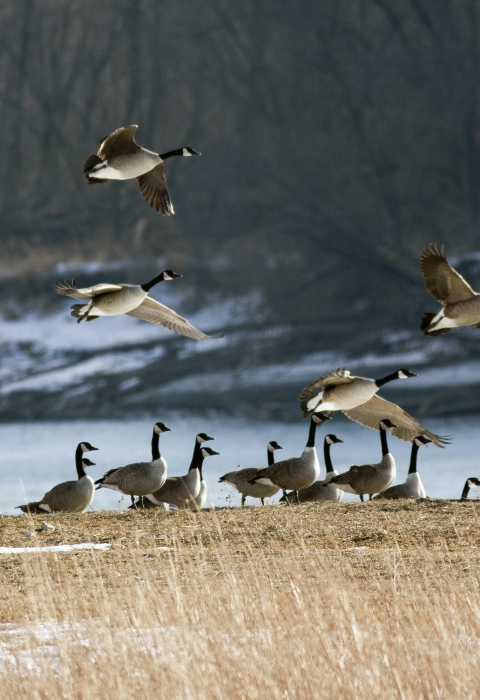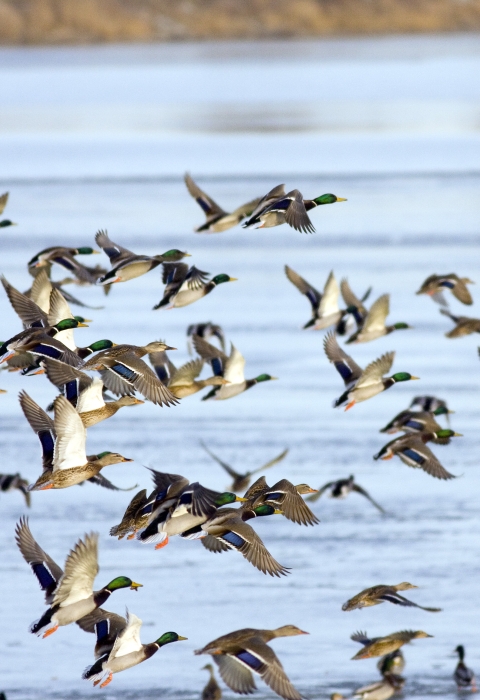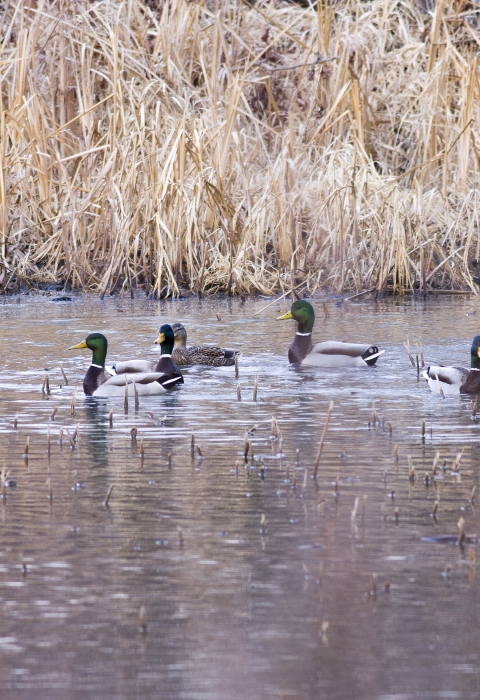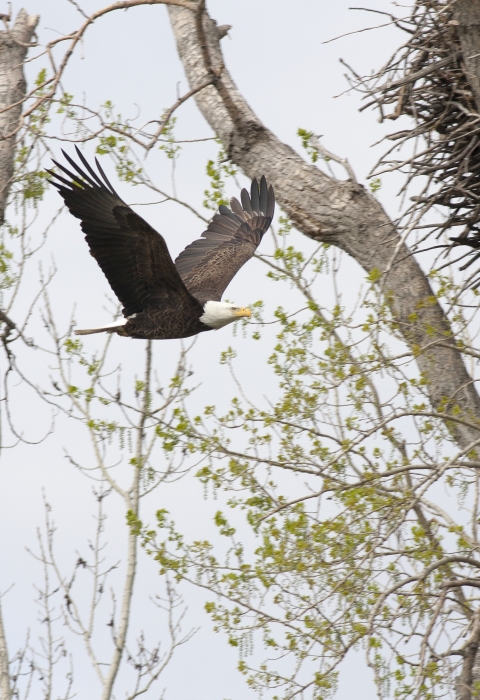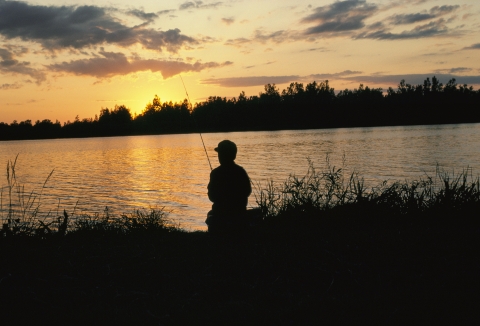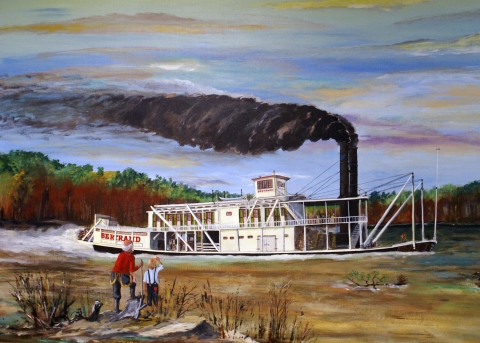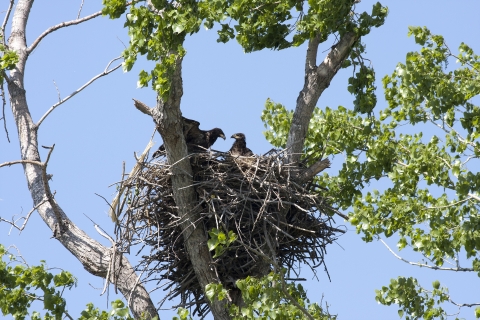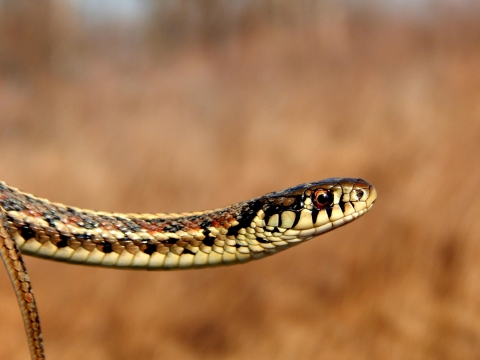Visit Us
National wildlife refuges offer us all a chance to unplug from the stresses of daily life and reconnect with our natural surroundings. At DeSoto National Wildlife Refuge, the changing seasons provide different opportunities to enjoy nature. During the spring and fall season, thousands of waterfowl find sanctuary in the refuge wetlands and on DeSoto Lake. The visitor center viewing windows and Bob Starr Wildlife Overlook are prime viewing areas for visitors to see this spectacular natural event. The peak of the migration is weather driven, but typically late October through early December are peak months in the fall and early March for the spring.
Along with the waterfowl migration come bald eagles. Prime bald eagle viewing can occur throughout the winter months with peak numbers in early December and again in early March. Look for bald eagles from the visitor center viewing windows, along the Missouri River Overlook and at Bob Starr Wildlife Overlook.
During the expanded public use season from April 15 - October 14, visitors can enjoy fishing and no-wake boating on DeSoto Lake. Common fish species caught include largemouth bass, crappie, bluegill and catfish. Sections of refuge grounds also open during this time for off-trail exploration. Visitors can try their luck finding and collecting mushrooms such as the prized morels in the spring. In the early summer, white-tailed deer and their fawns can be seen browsing in the early morning and evening hours. Woods, fields of native prairies grasses and brush along refuge roads attract a variety of songbirds and other wildlife, such as turkeys, pheasant, and bobwhite quail. Red-headed woodpeckers abound along the woodland edge. In summer, wood ducks broods can be seen in refuge ponds and secluded inlets of the lake.
The refuge also provides seasonal hunting opportunities for turkey and deer. Public archery units are open each year for both Nebraska and Iowa hunters. Special managed hunts such as a youth turkey hunt, disabled turkey hunt and antlerless muzzleloader hunts are available on an annual basis.
Throughout the year, visitors can enjoy the DeSoto National Wildlife Refuge visitor center. Besides the wildlife and habitat exhibits, the visitor center is home to an archeological collection containing almost 250,000 artifacts excavated from the buried wreck of the Steamboat Bertrand. The Bertrand Steamboat sank on April 1, 1865 along the treacherous bend of what is now DeSoto Lake. The muddy Missouri River quickly covered the boat in mud where it lay hidden for more than100 years. In 1968, the steamboat and its cargo where discovered on the refuge and unearthed the following year. The Bertrand cargo is on display in the visitor center and is remarkably well preserved. It offers a unique time capsule for researchers and visitors interested in America’s 19th century material culture. DeSoto National Wildlife Refuge truly provides a unique experience for visitors to experience the intersection of wildlife, habitat and history along the Missouri River floodplain!
Driving Directions
DeSoto National Wildlife Refuge is located 25 miles north of Omaha, Nebraska on Highway 30 between Missouri Valley, Iowa and Blair, Nebraska. From Omaha, take Interstate 29 north to U.S. Highway 30, Exit 75 at Missouri Valley, continue west on US Hwy 30 for five miles to the refuge entrance. Or take US Hwy 75 north to Hwy 30, going east five miles to the refuge entrance on DeSoto Avenue.
DeSoto National Wildlife Refuge
1434 316th Lane
Missouri Valley, IA 51555
GPS users: Please note that the south gate entrance to the refuge near Wilson Island is closed from October 15 - April 14. Please be sure that GPS directions take you through the Highway 30 entrance to the refuge.
Fees
DeSoto National Wildlife Refuge is a federal fee area and a valid entry permit is required to enter the refuge or travel on roads in the refuge. Daily entrance fees are $3.00 per vehicle. Daily fees are collected at the visitor center or self-service fee stations at entrances. Other valid entrance permits available at the visitor center include: the DeSoto National Wildlife Refuge annual pass ($15.00), commercial vehicle daily permits, a Federal Duck Stamp or a Federal Recreational Lands Passes including the America the Beautiful Interagency Passes: Annual, Senior, Access, Military, Every Kid Outdoors or Volunteer.
Restrooms
Restrooms are available inside the refuge visitor center during business hours. Pit toilets are also located on refuge grounds at the Cottonwood/Grassland Nature Trail parking lot, Middle Boat Ramp, and South Gate Recreation Area.
Points of Interest
Let our staff and volunteers at the visitor center help you plan your visit! This is a great starting point for visitors to become more familiar with the refuge and the wildlife that live here. Visitors can watch a 15 minute refuge orientation video, browse nature and wildlife exhibits and obtain maps and brochures. The visitor center also offers prime viewing windows onto DeSoto Lake and is a great place to view migratory birds from the comfort of the indoors. While there, visit the Friends of Boyer Chute and DeSoto Nature Shop for field guides, t-shirts and other educational items. The Bertrand Steamboat Museum is also found in the visitor center and includes displays showing the thousands of cargo items that were excavated from the Bertrand Steamboat which sunk in 1865.
Following a stop in the visitor center, take a drive on the refuge auto tour route. This route changes seasonally to minimize disturbance to migratory waterfowl. The paved section of road from the visitor center to the Missouri River Overlook and up to Bob Star Wildlife Overlook is open throughout the year to vehicles, bike riders, hikers and joggers. Along the route, stop and check out the Bertrand Excavation Site where the Bertrand Steamboat was discovered, or hike a trail at Cottonwood/Grassland Nature Trail. Wrap up the drive with a stop at the Bob Starr Wildlife Overlook. This viewing blind is a great place to view the migrating waterfowl during the spring, fall and winter months. It also is a great place to view bald eagles including a nesting pair that can be seen directly across the lake from the viewing blind.
During the expanded public use season of April 15 - October 14, visitors can explore off trail in the seasonally open sections of refuge land. Make sure to grab a refuge brochure and map to know the locations of where you can explore and abide by the “area closed” signs. In the spring, look for morel mushrooms in the bottomland forests when seasonal public use areas are open (starting April 15th). DeSoto Lake opens for fishing and no-wake boating during this time as well. The South Gate Recreation Area has a boat ramp as well as a handicap accessible dock and plenty of shoreline access for fishing.
What to Do
If visitors have 15-minutes
Stop in at the visitor center to get information about the refuge and to learn more about a future visit. You will not have time to explore the whole visitor center and exhibits, but take a quick peak out the viewing windows to see what wildlife you may be able to spot.
If visitors have one hour
Take your time to explore the visitor center wildlife exhibits and the Bertrand Steamboat Museum. The Bertrand Steamboat Museum contains thousands of 19th century artifacts from the steam-boating era and western expansion. During spring and fall migration, make sure to spend time at the viewing gallery windows looking out onto DeSoto Lake. During peak migration, thousands of ducks and geese along with numerous eagles can be seen right from these visitor center windows
If visitors have half a day or more
Start your visit exploring the visitor center and Bertrand Steamboat Museum. Following the visitor center, bring your binoculars (or check some out from the visitor center) and take a drive on the auto tour route and do some bird watching. Continue on the auto tour route to Bob Starr Wildlife Overlook and enjoy wildlife observation from the viewing blind. During spring, fall and winter, numerous waterfowl congregate in front of this blind. Bald eagles are also observed from this spot and an active eagle’s nest can be seen directly across the lake. If visiting during our summer public use season, try your luck fishing for some of the common fish species (bluegill, crappie, bass or catfish) or enjoy a paddle ride on the no-wake DeSoto Lake. During the refuge hunting season, head out to the archery units and try your luck harvesting a turkey or deer.
Know Before You Go
When planning a trip to the refuge, wear appropriate footwear and dress for the weather. Bring water, food, binoculars, field guides, a hat, sunscreen, insect repellent and anything else that might make the outdoor experience more enjoyable.
Visitor Tips
When planning your visit to DeSoto National Wildlife Refuge, remember that wildlife viewing changes based on the season. The peak waterfowl migration for which the refuge is known for typical occurs in November and then again in early March. Bald eagle viewing is best during the winter with peak numbers typically occurring in early December and then again in late February and early March. In general, the best time to view wildlife throughout the year is early morning and evening. Weekdays tend to be less busy than weekends, which also can help in viewing more wildlife. Binoculars are an important tool to help aid visitors in viewing wildlife. If you don’t have a pair, stop in at the visitor center where binoculars are available for loan. The visitor center also provides a great resource for learning about recent wildlife sightings and to pick up a map of the refuge to get orientated to the best places for wildlife viewing. Rangers and volunteers at the front desk are always happy to answer questions and provide tips. A wildlife sighting board is posted at the visitor center and provides insight into recent activity.
If you are looking to enjoy other activities on the refuge, remember that some recreational activities are only permitted seasonally. Fishing and no-wake boating on DeSoto Lake is permitted from April 15 - October 14. Bait is not sold at the refuge, but bait shops are located in the nearby town of Blair, Nebraska. If visitors have any questions regarding their visit please call the refuge at 712-388-4800. Staff and volunteers will be happy to provide information about their visit and any regulations regarding refuge activities.
Activities
Welcome to your national wildlife refuge national wildlife refuge
A national wildlife refuge is typically a contiguous area of land and water managed by the U.S. Fish and Wildlife Service for the conservation and, where appropriate, restoration of fish, wildlife and plant resources and their habitats for the benefit of present and future generations of Americans.
Learn more about national wildlife refuge . DeSoto National Wildlife Refuge provides a number of activities to enjoy nature throughout the year including hunting, fishing, hiking, wildlife viewing, photography and canoeing. Some of these activities are offered seasonally and have special regulations. To learn more about permitted activities, pick up a refuge regulation brochure when visiting or call refuge staff at 712-388-4800 with any questions.
Trails
Green Heron Trail
Open Season: April 15 - October 14
Length: 1.0 miles
Location of trail: Visitor Center
Surface: Fine, crushed rock with a wooden bridge over ditch.
Difficulty: Easy with minimal elevation changes
Information: The Green Heron Trail starts at the visitor center and circles around a restored wetland. Look and listen for birds and frogs in the wetlands. During the summer and early fall, monarchs can be seen visiting the milkweed and flowering plants. The trail is closed during the migration season to minimize disturbance to the migrating waterfowl.
Other Facilities in the Complex
Boyer Chute National Wildlife Refuge is another refuge managed by the staff of DeSoto National Wildlife Refuge and is located about one mile south on the Missouri River near Fort Calhoun, Nebraska. At Boyer Chute National Wildlife Refuge, the namesake side channel was restored after being blocked in 1937 to aid riverboat navigation. Following restoration, many of the wildlife species that historically utilized the land began to return and flourish in the area. On Boyer Chute National Wildlife Refuge, visitors enjoy hiking and birding along the nearly nine miles of hiking trails, hunting of white-tailed deer and turkey in the bottomland forests and fishing along the restored chute.
Rules and Policies
Welcome to your National Wildlife Refuge. DeSoto National Wildlife Refuge provides a number of activities to enjoy nature throughout the year including hunting, fishing, hiking, wildlife viewing, photography and canoeing. The refuge does have areas that are closed year round or seasonally to the public to provide important sanctuary areas for wildlife. To help protect and minimize disturbance to wildlife and its habitat, the refuge has other rules and regulations regarding activities on the refuge. To learn more about permitted activities, pick up a refuge regulation brochure when visiting or call refuge staff at 712-388-4800 with any questions.
Locations
DeSoto National Wildlife Refuge is located 25 miles north of Omaha, Nebraska on Highway 30 between Missouri Valley, Iowa and Blair, Nebraska. From Omaha, take Interstate 29 north to U.S. Highway 30, Exit 75 at Missouri Valley, continue west on US Hwy 30 for five miles to the refuge entrance. Or take US Hwy 75 north to Hwy 30, going east five miles to the refuge entrance on DeSoto Avenue.
DeSoto National Wildlife Refuge
1434 316th Lane
Missouri Valley, IA 51555
GPS users: Please note that the south gate entrance to the refuge near Wilson Island is closed from October 15 - April 14. Please be sure that GPS directions take you through the Highway 30 entrance to the refuge.
